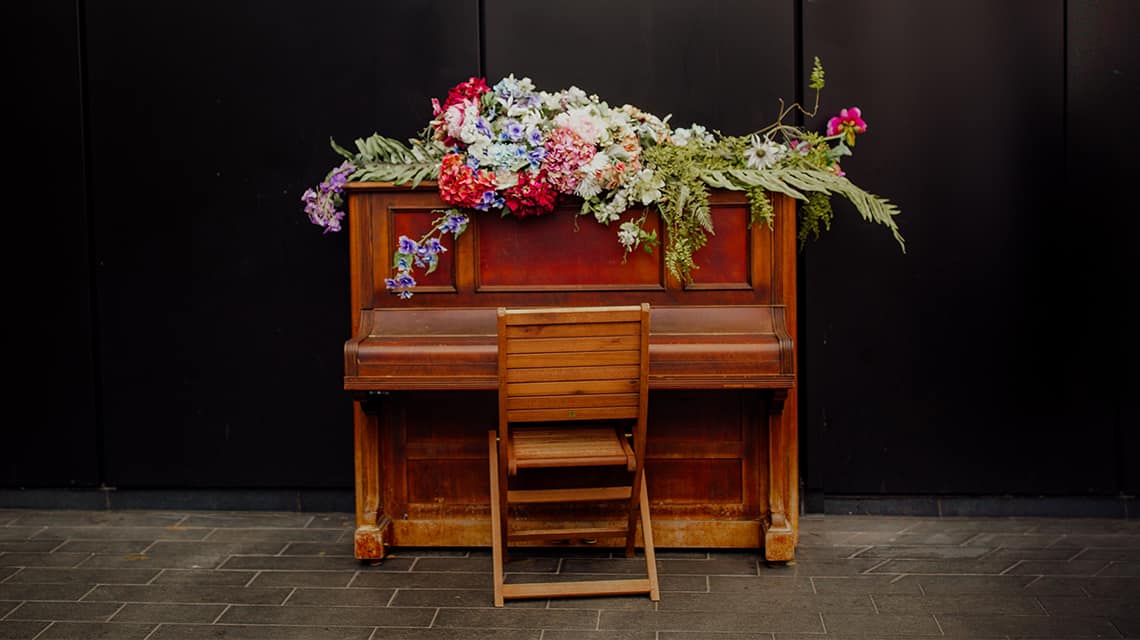How To Practice Music Away From The Piano

When we think about how to practice the piano, it’s usually assumed that all of our practice time happens at the piano. But, it’s often a good idea to take your score away from the piano and to give yourself a chance to think through your music in another light from time to time.
Studying music away from the piano is also a good use of your time for occasions when you can’t be at a piano. For example, during plane rides, in a waiting room, or when you’re away from your piano for extended periods of time are all times when you can still make progress on your music even without a piano.
Studying music away from the piano is a combination of listening to your music, making helpful observations about your music, and thinking through logistics of how to play your music.
Doing all of these things will optimize your at-piano practice time and ensure productive practice sessions when you are at the instrument once again. Here are some things to think about and do as you study your music away from the piano.
Listen
We’ve explored this topic in depth in another recent post, so be sure to read about it here. Listening to your music is a crucial and important part of the learning process. If you’re hoping to make some progress on your music but don’t have access to a piano, listening would be the next best thing.

Determine What the Music is Trying to Communicate
Devote some time thinking through and planning what you want your listeners to hear. Make a list of adjectives that describe what you think the music will convey. Use a combination of musical terms and other descriptive words. For example,
-
- This piece is allegro with a broad range of dynamics. It is in perpetual motion with a strong driving beat and full of energy. Or,
- This piece is slow and lyrical. The primary dynamic is piano and it’s very expressive.
Even though it seems counterintuitive, focusing on how you plan to play your music will make what you play fall into place. In other words, make it your goal to play as musically as possible from the earliest stages of your learning process. Then, the notes and rhythms are more likely to fall easily into place.
Ask Yourself Questions
Make as many observations from the score as possible.
-
- What is the time signature of your music? Does it remain the same or does it ever change?
- What key is your music in? Does it stay the same or do you ever move to a different key? Keep in mind you might move to a different key even without an official key change written in the music. If you spot a section with tons of accidentals, think about if you might be changing keys there.
- What is the roadmap of this piece? Are there any repeat signs? What about D.C. al coda or D.S. al coda? You may have to turn back a few pages to accommodate the roadmap. If this is the case, be aware of where you’re headed.
- What is the rhythm like? Are there any unfamiliar rhythms? Tap or clap any challenging rhythms away from the piano to help you learn them. If you notice any rhythms that seem challenging to coordinate between both hands, tap them hands separately, then together.
- Analyze the chords. Being aware of the chord progressions happening in your music is an excellent way to get to know your music really well. Many pianists skip this part of learning music but it’s a sure way to learn and remember your music much better and quicker than you would otherwise.
Practice On a Tabletop
This can’t possibly replace playing on real piano keys, but there is definitely some value to working through some parts of your music on any flat surface. For example, let your fingers walk through the fingering of any scale-like passages in your music. Take note if there is anything unconventional about the suggested fingering or if you think there will be any challenges with it.

Similarly, you can practice coordinating your hands. Air-play or tap your fingers and think through how your hands will work together or how you might need to practice coordinating different parts.
Are You Up For a Challenge?
Here’s an interesting challenge for you: Find a piece of music that you’ve never played before and see how much of it you can learn before you take it to the piano.
Try this with something that would be exceptionally easy for you to sight read and play. You can always level up after you’ve tried this a couple of times.
For example, let’s look at the first 2 lines of a Waltz by Gurlitt (Op.187 No.40).

Here are some ideas of things you can do away from the piano:
-
- Listen to the piece.
- Find a good recording or compare a couple of recordings.
- Use active listening techniques and get to know the music.
Now, let’s talk through these measures and take it a bit further.
- Remember to first think about how you want the music to sound. Imagine ballroom dancers floating effortlessly around a dance floor. You’ll want your listener to visualize this as well and maybe they’ll even tap their foot, sway or move to the music. Since this piece is marked piano you’ll want to play softly and keep the music graceful and light.
- Notice that the melody is in the left hand and it’s marked marcato, so you’ll want to give it some strength while the right hand lightly plays the off beats. This balance between a strong left hand and a lighter right hand is something you can definitely practice away from the piano.
- Since it’s a Waltz, it’s in 3/4 time. Tap the rhythm of each hand. Tap and hold a strong downbeat with your left hand on beat one and 2 lighter notes with your right hand on beats 2 and 3 of each measure.
- Notice the melodic line is in the left hand. Set your left hand on a flat surface and air-play those notes, holding each one for 3 beats. Follow the fingering that is suggested. On the C# at the end of the first line, actually reach your 2nd finger up to an imaginary black key. For the E’s in measure 9, reach your thumb over, just as you would on actual piano keys.
- Hum the notes as you move your fingers and imagine what they would sound like. Or, say the finger numbers or letter names that you would be playing.
- Notice that this excerpt has three 4-bar phrases. As you’re thinking through those left-hand notes, think about how you’ll play the left hand somewhat firmly since each one falls on a downbeat and because it is labeled marcato.
- Think about how you will shape each of those 4-bar phrases. You don’t want to treat each left-hand note equally so think about how you will start each phrase a little softer, let it build in the 2nd and 3rd measures then fall again in the 4th measure.
- Next, think about what you’ll need to do to play the correct right-hand notes. One approach would be to plan out what the note names are and to remember them. A better approach would be to think of the right-hand notes as the completion of a chord. In measures 1-4, you have the 3rd and 5th notes of a C chord, E and G. In measures 5-8, think of the F and G as part of a G7 chord. In measures 9-12, notice that you start with the interval of a 4th, which makes an inverted C chord. Then, the upper note is moving down to make a 3rd, then a 2nd and finally it returns to a 4th. Also, take note that these upper notes are following the contour of the left-hand note. As the left-hand steps down, so does the upper right-hand note.
Once you’ve thought through all of this, head over to your piano and see what you can play without relying on the music.

It’s a win-win. Maybe you can remember all of the details and you have some music completely learned after only 1 attempt at the piano. But, if not, you’re still ahead of the game because you already know the most important things to be thinking about as you continue to learn the music. Hopefully, you won’t be mindlessly reading the notes and ignoring many of the details once you are at the piano.
Try out some of these tips and you’ll be on your way to smarter practicing.

